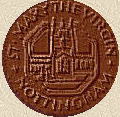 The
History of the Parish Church of St. Mary the Virgin, Nottingham - Strange
Changes
The
History of the Parish Church of St. Mary the Virgin, Nottingham - Strange
Changes The
History of the Parish Church of St. Mary the Virgin, Nottingham - Strange
Changes
The
History of the Parish Church of St. Mary the Virgin, Nottingham - Strange
Changes
In the first years of the new Protestant era, on 6 August 1690, Benjamin Camfield, MD, was instituted as Vicar, Patron the Earl of Kingston. Camfield, who died on 12.9.1693, was also Rector of Aylestone, near Leicester, where he was buried. His widow, Martha, was buried at St. Mary's on 3.11.1698. Godfrey cited the RBN, as showing "Master Campfield, Viccar or Minister of the Parish of Saint Marye's in this Town, shall have paid vnto him the Sume of five pounds a quarter dureing such time, and so long, as this House shall think convenient: the first payment to be made at Christmas next", that being ordered by the Common Council on 28.9.1691.
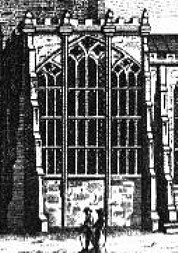 In 1693, the great South window was taken down and
renewed; the frontage, however, was a flat-topped oddity and remained so
until the 1800s (illustrated in Blackner, extract right). Blackner had the
vicarage as vacant during this year, but the Registers show that this was
so only for the last three months or so (Blackner also had Camfield's name
misspelled as Carnfield).
In 1693, the great South window was taken down and
renewed; the frontage, however, was a flat-topped oddity and remained so
until the 1800s (illustrated in Blackner, extract right). Blackner had the
vicarage as vacant during this year, but the Registers show that this was
so only for the last three months or so (Blackner also had Camfield's name
misspelled as Carnfield).
In 1694, Timothy Caryl, MA, was instituted as Vicar on the death of Camfield but he resigned in 1698, Patron the Earl of Kingston. A Timothy Caryll, Bachelor, was buried at St. Mary's on 22 .1.1727 but Godfrey thought this probably was a son of Rev. Caryl). Elizabeth, daughter of Timothy and Elizabeth, was baptized at St. Mary's on 23.5.1695. Godfrey cited RBN as continuing the "quarteridge... which hath beene paid to his predecessors" from the Town Council.
On 1 September 1698 came the institution of Edward Clarke, MA, as Vicar, Patron the Earl of Kingston. The same year, he had the Chancel roof releaded, "being very much in decay". This was paid from the great tithes of farmers and in a very few years, before resigning in 1708, this Vicar had considerable repairs and improvements made to and in the church.
1699 saw the lowering of the bells because "it was feared their swinging might injure the fabric" (of the tower). A sixth bell was added and the whole peal lowered from only 20 feet from the top of the tower. The timber frame was "in great decay" so the bells were rehung by John Crow on a stage lower than the former by 22 feet, the bells were then rung from the church floor.
 At
the dawn of the eighteenth Century Jan Siberechts painted a prospect of
Nottingham from the east (dated 1700, in the Castle Museum). In a close-up
of St Mary's there seems to be a remarkable raised end, with pinnacles on
the top of the South Transept. These seem more exaggerated than on the
North Transept, which matches the size shown in the 1677 north-east view
(see the previous Chapter). Had someone decided on an "improvement"
to emphasize the importance of St Mary's as one approached from the London
road? If the date above for the rebuilding of the south face is correct
then the date of this painting has to be before 1693. The Vicarage with
its Dutch gabled end can be seen across the road to the left.
At
the dawn of the eighteenth Century Jan Siberechts painted a prospect of
Nottingham from the east (dated 1700, in the Castle Museum). In a close-up
of St Mary's there seems to be a remarkable raised end, with pinnacles on
the top of the South Transept. These seem more exaggerated than on the
North Transept, which matches the size shown in the 1677 north-east view
(see the previous Chapter). Had someone decided on an "improvement"
to emphasize the importance of St Mary's as one approached from the London
road? If the date above for the rebuilding of the south face is correct
then the date of this painting has to be before 1693. The Vicarage with
its Dutch gabled end can be seen across the road to the left.
In 1702 Queen Anne came to the throne. A key
event of her reign, until 1714, was the Act of Union in 1707, which
formally united England and Wales with Scotland, to form Great Britain.
The next year a new pulpit, canopy, reading desk, etc. and 2 pews
adjoining fronting "each Ally were erected at ye charge of ye
parish". Soon after Mark Beardsley was paid 3/4d for mending the
well by St. Mary's church. To the east, as Siberecht's painting shows
(right), the land bordering Hollow Stone remained open gardens and
orchards. 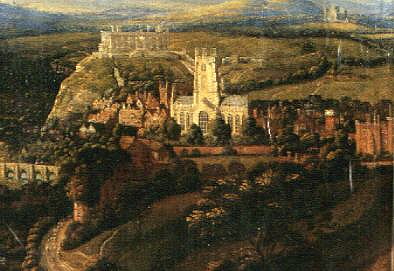 1705
saw a new organ and new set of "Railes at ye
Altar". Deering, writing around 1740 noted "there
were no Organs till the Reign of Queen Anne, when about 1704 by the
Subscription of the Parishioners, Organs were purchased, and set up at the
West End of the middle Isle" (Deering was wrong in that we now
know of the records of an organ in 1588-9). Further, a Parish register
memorandum noted - "In 1705, the new organ was erected, at the
expense of £212 15s. 9d., raised by the generous contributions of the
Right honourable the Earl of Kingston and several others". T C
Hine, in 1876, had this as "In 1704, the organ was refitted and
removed to a gallery at the west end of the church", that he
described as a repositioning of an existing organ which was on a gallery
across the chancel arch, asserting that the pipes had been sold by "some
zealous puritan churchwarden", but he wrote also of "two
pillars doing duty as a chancel screen, and supporting the effigies of a
lion and unicorn". Those effigies, assuming they are those still
in the church, they date from the reign of Queen Anne, bearing as they do
the Queen's Arms after the 1707 Act of Union, Hine's suggestion was wrong.
1705
saw a new organ and new set of "Railes at ye
Altar". Deering, writing around 1740 noted "there
were no Organs till the Reign of Queen Anne, when about 1704 by the
Subscription of the Parishioners, Organs were purchased, and set up at the
West End of the middle Isle" (Deering was wrong in that we now
know of the records of an organ in 1588-9). Further, a Parish register
memorandum noted - "In 1705, the new organ was erected, at the
expense of £212 15s. 9d., raised by the generous contributions of the
Right honourable the Earl of Kingston and several others". T C
Hine, in 1876, had this as "In 1704, the organ was refitted and
removed to a gallery at the west end of the church", that he
described as a repositioning of an existing organ which was on a gallery
across the chancel arch, asserting that the pipes had been sold by "some
zealous puritan churchwarden", but he wrote also of "two
pillars doing duty as a chancel screen, and supporting the effigies of a
lion and unicorn". Those effigies, assuming they are those still
in the church, they date from the reign of Queen Anne, bearing as they do
the Queen's Arms after the 1707 Act of Union, Hine's suggestion was wrong.
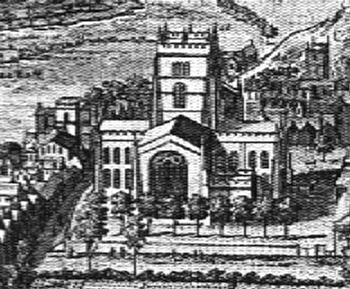 A
change to the church exterior appears to be visible in a 1708
drawing by Jan Kip (left, Local Studies Library). At the risk of being
over-speculative it seems the top of the South Transept had been altered?
That of the North Transept remains as it as it was built. Maybe the
enhancement shown by Siberechts had proved unstable and was in danger of
falling off. If the date of Siberecht's painting was correct at 1700, the
change, purported to be of 1693 may possibly matche the work in 1707
when the first clock in the Tower, with a single south face, was
built by Rowe of Epperstone. In the same year, a South loft or
gallery was built, closely followed by a new ringing loft resting
upon supporters which projected from the four centre columns which
supported the tower; access being from the now-blocked doorway in the
south aisle turret (above the Smith monument), this loft was removed in
1807.
A
change to the church exterior appears to be visible in a 1708
drawing by Jan Kip (left, Local Studies Library). At the risk of being
over-speculative it seems the top of the South Transept had been altered?
That of the North Transept remains as it as it was built. Maybe the
enhancement shown by Siberechts had proved unstable and was in danger of
falling off. If the date of Siberecht's painting was correct at 1700, the
change, purported to be of 1693 may possibly matche the work in 1707
when the first clock in the Tower, with a single south face, was
built by Rowe of Epperstone. In the same year, a South loft or
gallery was built, closely followed by a new ringing loft resting
upon supporters which projected from the four centre columns which
supported the tower; access being from the now-blocked doorway in the
south aisle turret (above the Smith monument), this loft was removed in
1807.
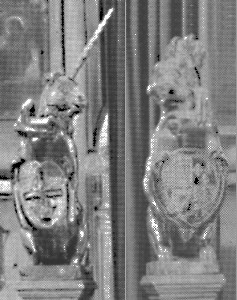 Presumably
in about 1708, the Lion, Unicorn and Crown on
cushion were made. The coat of arms borne by the Lion is that of Queen
Anne, after the Act of Union in 1707. all were rescued from the Vestry in
1933 (?) by Messrs W.P. Snook and W. Marshall, churchwardens; and,
restored in 1958 (the linked picture shows the west door in 1942). 1708 also saw the institution, on 19 June, of Samuel
Berdmore, MA, as Vicar, Patron, the Marquis of Dorchester. He resigned
the Vicarage in 1723, and died in 1742.
Presumably
in about 1708, the Lion, Unicorn and Crown on
cushion were made. The coat of arms borne by the Lion is that of Queen
Anne, after the Act of Union in 1707. all were rescued from the Vestry in
1933 (?) by Messrs W.P. Snook and W. Marshall, churchwardens; and,
restored in 1958 (the linked picture shows the west door in 1942). 1708 also saw the institution, on 19 June, of Samuel
Berdmore, MA, as Vicar, Patron, the Marquis of Dorchester. He resigned
the Vicarage in 1723, and died in 1742.
In 1713 a Mr. Hallam was paid £1-7-2d for repairing and working the fire engine [fier Ingen] at St. Mary's, and in 1714 the throne went to George I, then Elector of Hanover, and a great-grandson of James I. George reigned until his death in 1727. Around 1714 (but perhaps the date is slightly wrong and should be earlier), the roof of the south transept was repaired and tie beams were put in; a beam dated 1617 was found at the time. In 1716 the Fire engine was repaired again, and, in 1717-18, William Stocks was paid 10/4d for Rivening and Wool stuffing the Corporation seat at St. Mary's.
Exteriorly, 1719 saw the removal of a house from the northwest end of the churchyard (the rent from which apparently went to the Vicar, as the incumbent, Samuel Berdmore, was to be paid £2 per annum by way of compensation). Possibly this house is visible in Kip's drawing. Inside the church, a new altarpiece in the "Corinthian order" was erected with oak wainscotting round it and the floor was raised one step, with new paving, rails, etc. Joseph Smith and James Haynes were churchwardens. According to Wylie, the altarpiece "blocked up a portion of the east window" (Blackner dated this as 1727). Then in a ceiling "in the Antechurch (or Nave)was drawn in 1720, till then it was open to the timbers".
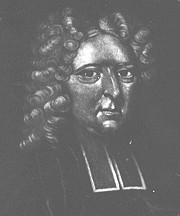 In
1723, John Disney, MA, was instituted as
Vicar, Patron the Duke of Kingston. His memorial is in the church and
there is a portrait in the Vestry. Hood noted that Disney was
non-conformist until the age of 21, and a magistrate till he was 42.
Born at Lincoln, on 26.5.1677. Married Mary Woodhouse, and had 5 sons
and 3 daughters. He entered holy orders in 1719 and was priest in
country parishes in Lincolnshire until being appointed to St. Mary's.
Died on 3.2.1729, and buried at St. Mary's, 6.2.1730. His gravestone,
simply marked J.D. 1729/30, but the inscription now worn away (?), was
in the chancel but was moved to the nave. Godfrey related how "this
business-like Vicar kept his register in perfect order".
Gervase Disney, MB, probably a son, married Mary Thorpe at St Mary's on
20.5.1736, and a daughter, Martha was baptized in St. Mary's on
29.3.1735. Then in 1724, large brass chandeliers
were given by Mr. Greaves. The same year has the story of how the Vicar,
John Disney, refused to let the newly-appointed Bishop of Lincoln, Dr.
Reynolds, "make a tippling-house of St. Mary's Church as long
as he was its Vicar". Hood has this story as involving "Archbishop
Blackburne", which Godfrey also noted, as a story from Sutton's
Date-book, as the Archbishop of York. In 1725, Mr.
Mark Anthony Dallam (or Dalom) was appointed to repair the Organ. In
1723, John Disney, MA, was instituted as
Vicar, Patron the Duke of Kingston. His memorial is in the church and
there is a portrait in the Vestry. Hood noted that Disney was
non-conformist until the age of 21, and a magistrate till he was 42.
Born at Lincoln, on 26.5.1677. Married Mary Woodhouse, and had 5 sons
and 3 daughters. He entered holy orders in 1719 and was priest in
country parishes in Lincolnshire until being appointed to St. Mary's.
Died on 3.2.1729, and buried at St. Mary's, 6.2.1730. His gravestone,
simply marked J.D. 1729/30, but the inscription now worn away (?), was
in the chancel but was moved to the nave. Godfrey related how "this
business-like Vicar kept his register in perfect order".
Gervase Disney, MB, probably a son, married Mary Thorpe at St Mary's on
20.5.1736, and a daughter, Martha was baptized in St. Mary's on
29.3.1735. Then in 1724, large brass chandeliers
were given by Mr. Greaves. The same year has the story of how the Vicar,
John Disney, refused to let the newly-appointed Bishop of Lincoln, Dr.
Reynolds, "make a tippling-house of St. Mary's Church as long
as he was its Vicar". Hood has this story as involving "Archbishop
Blackburne", which Godfrey also noted, as a story from Sutton's
Date-book, as the Archbishop of York. In 1725, Mr.
Mark Anthony Dallam (or Dalom) was appointed to repair the Organ. |
 In
1726 the West end had to be rebuilt, this was
done in a strange Classical Doric style. Stretton noted this was at
instigation of Alderman Traverse (of where? not Nottingham, as I have
found no records of him) and had the date as 1762, by "Hirons of
Warwick". The right-hand illustration was drawn by the architect
T C Hines (who published in 1876, but may well have drawn it from memory
as he was then aged 63). The left-hand view is an computer-converted
extract from the church as drawn by Wilkins in 1815 (published by
Blackner).
In
1726 the West end had to be rebuilt, this was
done in a strange Classical Doric style. Stretton noted this was at
instigation of Alderman Traverse (of where? not Nottingham, as I have
found no records of him) and had the date as 1762, by "Hirons of
Warwick". The right-hand illustration was drawn by the architect
T C Hines (who published in 1876, but may well have drawn it from memory
as he was then aged 63). The left-hand view is an computer-converted
extract from the church as drawn by Wilkins in 1815 (published by
Blackner).
A major architect of the day, Colen Campbell, was active in Nottingham at the time (main source Stutchburg, 1967). Although there does not appear to be a documented direct connection between Campbell and St Mary's, it may be more than coincidence that he was employed by Plumptre to make improvements to Plumptre House. The first drawings for the improvements interestingly were by Plumptre himself, in 1710 to 1723. Campbell seems to have been primarily responsible for the construction in 1724 of a Palladian "South front looking into ye Church Yard" (below, left). So here we have an architect involved in neo-classical styles and an immediate local resident, with strong family connections with the church, "on site", so to speak, at almost exactly the time the west front of St. Mary's was rebuilt in a neo-classical style - with a pediment of a Grecian Urn and a general Doric form.
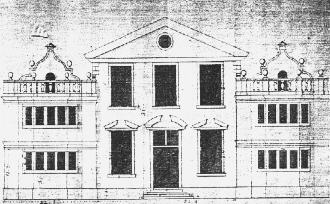 Francis
Hiorne, mentioned by Stretton, is of the next generation (living in
1744-89, or 1748-95 according to Mordaunt Crook). Francis, the elder son
of William, specialized in the Gothic style and did work at Arbury in
Warwickshire and Tetbury Church, Gloucester (1777-81). Here we may find a
link with St Mary's, remote though it is, as Arbury was the seat of the
Newdigate family. A monument, once in the chancel, to "Thomas
Newdegate, Esq., the third son of Sir Richard Newdegate, of Ardbury, co.
Warwick, Bart., Serjeant-at-Law", who died on January 24th,
1722, can be found in the north aisle. The Hiorne brothers, William (c.
1712-1776), a mason, and David (1715-1758), a carpenter, were from
Warwickshire. In 1747, they succeeded to the business of a family named
Smith in Warwick. The brothers specialized in the Palladian style and
built a church at Daventry, Warwickshire, with a neo-classical west end in
square regency shape and an impedimented doorway. Stutchburg's book on
Colen Campbell has a Table of his contemporary architects and builders
which includes David & William Hiorne, showing their earliest minor
work as around 1748, with most of their public buildings in 1752-9, 1763-4
and finally 1770-1.
Francis
Hiorne, mentioned by Stretton, is of the next generation (living in
1744-89, or 1748-95 according to Mordaunt Crook). Francis, the elder son
of William, specialized in the Gothic style and did work at Arbury in
Warwickshire and Tetbury Church, Gloucester (1777-81). Here we may find a
link with St Mary's, remote though it is, as Arbury was the seat of the
Newdigate family. A monument, once in the chancel, to "Thomas
Newdegate, Esq., the third son of Sir Richard Newdegate, of Ardbury, co.
Warwick, Bart., Serjeant-at-Law", who died on January 24th,
1722, can be found in the north aisle. The Hiorne brothers, William (c.
1712-1776), a mason, and David (1715-1758), a carpenter, were from
Warwickshire. In 1747, they succeeded to the business of a family named
Smith in Warwick. The brothers specialized in the Palladian style and
built a church at Daventry, Warwickshire, with a neo-classical west end in
square regency shape and an impedimented doorway. Stutchburg's book on
Colen Campbell has a Table of his contemporary architects and builders
which includes David & William Hiorne, showing their earliest minor
work as around 1748, with most of their public buildings in 1752-9, 1763-4
and finally 1770-1.
1727 saw George II succeed to the throne, reigning until 1760. In the same year the Quire stalls were repaired "again", plus a "very handsome Altar piece".
On 19 June 1730, Thomas Berdmore, MA, was instituted as Vicar, Patron the Archbishop of York (Blackner wrote, as "the Duke's representative"). He was married to Martha, a daughter Caroline (born 27.7.1735) was baptized in St. Mary's, as was a son, Thomas, on 24.5.1740. Thomas Berdmore, the elder, resigned the living in 1743. The second Thomas became renowned as the King's Dentist, and a marble tablet, now in the north aisle (by the choir vestry door) records how he "acquired a liberal And ample Fortune by the Profession of Dentist. He died the 7th of Novr 1785, aged 45 years".
In 1731 the Vestry was "plaistered"; L. Garratt and C. Taylor were Churchwardens (Stretton, found a note "on a table in St. Mary's vestry" in 1803). Than in 1737/8 a north Loft was built, according to Blackner, "the wainscoting of this chapel [of All Saints] was taken down by one Stocks, a joiner".
Outside in 1740, Hollow Stone was widened and lowered. Inside in 1741, on 25 September, a Vestry meeting decided the organ had to be repaired, and if it were to be moved backwards, "from the loft wherein it now stands and a new loft built for the same", it would make room for new seats in the then present loft. The Corporation agreed to give 5 guineas to churchwardens to make more seats in the church and to repair the organ. This was done in 1742 by Swarbrick of Warwick, and a loft was built with two side lofts adjoining.
We next see the church pictured in a 1741 East panorama, by Sandby, No 4 is Plumptre House. The gardens down the eastern slope seem to have been filled with buildings and, in close-up, the South Transept roofline and pinnacle height both are the same as that of the North Transept .
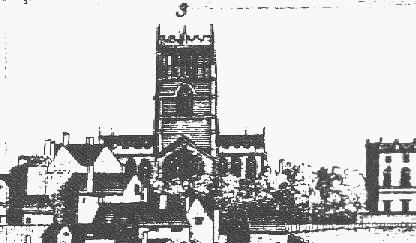

 The
Badder & Peat map of 1744 (right), has a drawing
of the church from the south and the flat-top to the South Transept is
clearly visible. The
Badder & Peat map of 1744 (right), has a drawing
of the church from the south and the flat-top to the South Transept is
clearly visible.
1743 saw the Institution of Scrope Berdmore, DD, as Vicar, Patron the Duke of Kingston. Son of Samuel Berdmore, Vicar 1708-23. Scrope was Vicar until he died on 16.2.1770., buried in St. Mary's, 23.2.1770. He was also Vicar of Sneinton and Wollaton, and Rector of Holme Pierrepoint and Adbolton. His portrait is in the Vestry (?). Married first to Mary, who died 30.10.1745 and buried in St. Mary's; second, to Genevova. By the first he had a son, Scrope (born 23.11.1744) baptized in St. Mary's on 19.12.1744. By the latter he had a daughter, Margaretta (born 10.1.1755) baptized in St. Mary's on 1.2.1755, and a son, Evelyn (born 18.1.1756) baptized in St. Mary's on 9.2.1756. Scrope, Mary and Evelyn, are commemorated on a large floorstone in the "crossaisle" of the nave; Genevova's memorial is a floorstone at the west end of the nave - Godfrey wrote - "It is nothing less than scandalous that these two stones, which have probably been removed from the chancel, should now be placed many yards apart". On August 23, 1750 a severe earthquake was felt.
|
:

A drawing purportedly dated 1815 also shows the flat top to the South Transept and, as with Badder & Peat's Map, shows the Palladian urn on the west end. |
In 1754, Mr John Thornhaugh was elected MP for the County. Formerly named Hewitt, he succeeded to the Thornhaugh estates in 1756, as the last male descendant of Colonel Thornhaugh, and held the estates until his death in 1787. The family mansion was on the east side of St. Mary's Hill. On July 18, the chapel on High Pavement was registered for the use of Protestant Dissenters (Presbyterian) and a chapel in Castle Gate was registered for use by Protestant Dissenters (Independent), the latter was certified by, among others, Ichabod Wright and his son, John. Both were buried in St. Mary's (plaques in the north aisle, west end).
George III succeeded his father in 1760. He reigned until 1820, although periodic bouts of insanity led to his son, later George IV, being Prince Regent from 1811. 1761 saw the South front of the nave refaced with new stone; but this was poor quality (Dim'n) stone and the refacing had to be redone in 1812-4? (pre-1815) [Dim'n = Castle Donington? was used by Pickford of Derby, for County Hall, 1769, where it also deteriorated very quickly]. 1761 also saw the Coronation of George III, and Queen Charlotte. At 10 o'clock a service was held at St. Mary's when a coronation anthem , composed by Mr. Wise, the organist, was performed by a large choir. The next year 1762 was when the streets of Nottingham were first lit. This was by oil lamps, with globular glass bottoms. In 1764 record was made of award of a contract to Mr. Thompson of Lichfield, to re-erect the Leen Bridge, in Red Lion Square, having "recently repaired the churches of St. Peter and St. Mary". The old bridge had extended 600 feet and contained 23 arches. Inside the church in 1765, the Corporation seats were repaired. What work Thompson had done at St Mary's is not clear but this may explain Stretton's date of 1762 for the west front. The Guide to St. Peter's Church, by Alan Derry, 1983, has no corresponding date; the nearest being an extensive refurbishment in 1719, when the gallery was repositioned in the north aisle.
Locally, 1768 was when the first cotton mill in the world was built on a piece of ground between Woolpack Lane and Hockley, by Richard Arkwright, the inventor of the spinning frame. Lack of power, the machinery was worked by horse power, proved too expensive and a (now much more famous) water power factory was opened at Cromford in Derbyshire (the factory itself was destroyed by fire in 1781).
A year later, in 1769, the County Hall, on High Pavement had to be rebuilt and enlarged. The contract was entered into by a builder named Pickford of Derby, who completed it for £2,500 (see above). Joseph Pickford (1734-1782) was a leading architect in Derbyshire in the reign of George III. At least initially, Pickford supervised building work for the Hiorne brothers. He did a design for the restoration of the Gothic windows at St. Mary's in 1770 (Nottingham University Library MAB 115). He also rebuilt and enlarged the County Hall on High Pavement in 1769, apparently using Castle Donington Stone, which proved to be of poor quality. It seems a strong possibility that it was Pickford who did the much-maligned refacing of the outer facing of the south aisle - "west of the aisle [transept]..which was new faced in 1761 .. with such perishable stone", described by Blackner in 1815.
1770 saw the Induction of the Rev. Nathan Haines, DD, inducted to the living at St. Mary's, vacant by the death of Dr. Berdmore; Patron the Duke of Kingston. He died while still Vicar on 27.4.1806. His memorial is on the north aisle wall, listing his plurality of livings - as with Scrope Berdmore (above). Haines was Proctor of Oxford University in 1766, while at St. Mary's he was Prebendary of Southwell, Rector of Cotgrave, Perpetual Curate of Snenton (Sneinton) and Tong (in the County of York) and first Domestic Chaplain to the Earl Manvers. Another keeper of excellent Registers. Married twice. First to Susanna, buried in St. Mary's 17.7.1773 (memorial stone is/was in the nave), by whom he had six sons and one daughter. Then to Ann, a member of the Tempest family, whose seat was Tong, by whom he had one son, Nathan Tempest, baptized in St. Mary's on 31.8.1781, and (presumably,) a daughter Elizabeth. Ann survived him and was buried in St. Mary's on 11.7.1811 (memorial in the north aisle). On 3.8.1787, he married his daughter Jane On 14.6.1802, he married his (?) daughter Elizabeth to the Hon. Walter Hutchinson, Vicar of the Parish of Barton-in-Fabis. Witness included Hugh Chudleigh Haines, Isabella Haines, Harriot Haines and N. Tempest Haines. Also "the only fire engine kept in the town was stationed in the ante-church at St. Mary's. This was so for many years subsequently" (people alive in 1850 could remember so.
1773 showed the parish inhabitants
starting to grow significantly in numbers, as the total number of houses
assessed to the poor rate in St. Mary's parish was 1522, having been 652
in 1724; in 1850, 9,900; and in 1878, 20, 611. In 1775 a
society of bell-pullers rang, with the ten bells in St.
Mary's, in seven and a half hours, 11,340 grandsire castors - "a
performance never, we believe, surpassed, and never likely to be again
attempted". Mr. W.D. Crofts, solicitor, rang the ninth bell
during the whole time. Mr. Richard Peat, of Queen Street, needle-maker,
the last survivor, died in 1829, aged 74 years. Workmen demolished an
ancient house on High Pavement, at the corner of Garner's Hill, and in the
Early English style (with each story projecting 2 feet or more beyond the
one below it, so that the top story was more than 9 feet wider than the
ground floor), perhaps nearly 600 years old.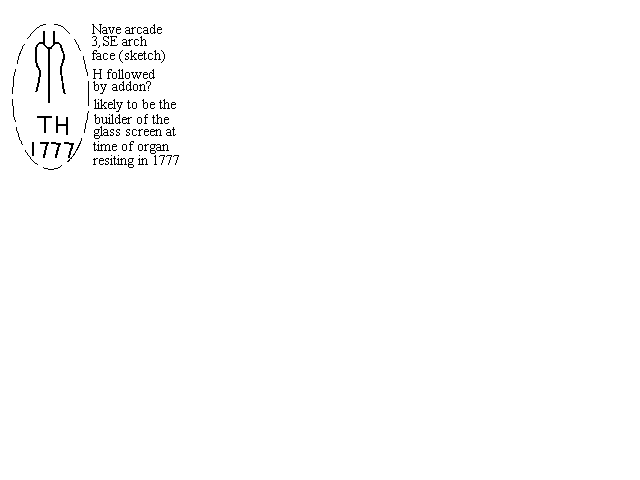
On 15 June 1777, the organ built by "Snezzler", of Oxford Road, London, was opened this month. The builder was John Snetzler (from his signature). From Blackner's description it appears to have been in the same position as its predecessor; as "a glass partition was run across the church, at the back of the Quire, in 1798". He wrote also "The instrument was supported behind the Quire by two Tuscan columns, over which David is painted as playing on his harp". The symbol and initials in my drawing (right) presumably link to this work.
1778 saw the death of Mrs. Margaret Middleton, at her house in Bridlesmith Gate, aged 100 years. She was a direct descendant of Sir Hugh Middleton, who had spent a fortune of £400,000 supplying London with water. She had lived in Nottingham 80 years and was interred near Lady Mary Brabazon, her close friend, in the chancel of St. Mary's. In the burials Register appears Mr. Michael Kayes, 24.11.1778, with the footnote by Godfrey - he appears to have had a son, also named Michael, who married at St. Mary's, 6.4.1779, Ann Ward. "Kayes Walk, on the north side of the churchyard is probably named after this family".
On September 25, 1779, a census, paid for by public subscription, determined that in St. Mary's Parish there were 2314 houses, 2584 families and 12837 inhabitants. By comparison the figures for St. Peter's parish were, 446, 497 and 2452; while in St. Nicholas's Parish they were, 413, 475 and 2502.
In 1785 Mr. William White, aged 91 years, died. For upwards of 37 years he had been Sexton of St. Mary's Parish, responsible for the interment of 11,234 persons. An election with four candidates took place to fill the post, Mr. Samuel Creswell, formerly a printer and bookseller, was successful. The next year Poor houses were built for St. Mary's. there were 12 small tenements, called the "White-rents" in York Street, for poor aged people. On February 5, 1788, a true and complete peal of 5040 changes Bob Royal (ten in) was rung on the deep-toned peal of ten bells at St. Mary's, by a select company of the Nottingham Society. It took 3 hours and 44 minutes.
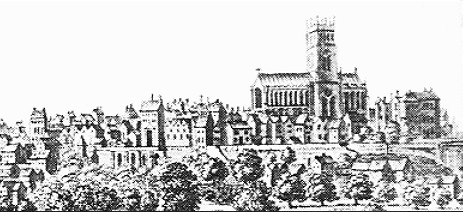 The
explosive growth of the Parish continued,. In 1790,
there was concern over the increase in houses valued at under £10 per
annum rental. This increased the burden, potential if not actual, on
wealthier inhabitants to provide for the support of the poor and led to
the holding of a vestry meeting on October 22. Alderman Fellowes died at
his house on High Pavement, aged 63, formerly in silk manufacture. His
remains were deposited in the family vault in St. Mary's churchyard.
The
explosive growth of the Parish continued,. In 1790,
there was concern over the increase in houses valued at under £10 per
annum rental. This increased the burden, potential if not actual, on
wealthier inhabitants to provide for the support of the poor and led to
the holding of a vestry meeting on October 22. Alderman Fellowes died at
his house on High Pavement, aged 63, formerly in silk manufacture. His
remains were deposited in the family vault in St. Mary's churchyard.
1791 was notable for the death of John Plumptre, Esq., of Plumptre House, aged 79. His remains were deposited in the family vault in St. Mary's. "The Plumptre family, up to this date, had been residents in the town from the time of Edward I (1239-1307). The old family mansion in Stoney Street was demolished in 1860".
We now come to a new era with the arrival on the scene of William Stretton, who could be seen either as a villain or a hero in the history of St Mary's.
![]() William Stretton - villain or hero?
William Stretton - villain or hero? ![]() Return to History - Introduction
Return to History - Introduction ![]() Main Home Page
Main Home Page
Strange Changes - Compiled by Brian Taylor, published September 2000
stmarys/history7.htm